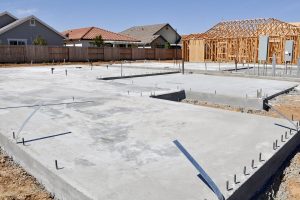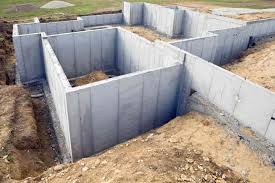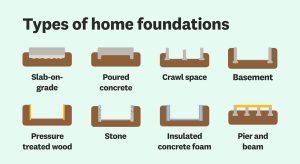


The Role of a Foundation
The foundation is one of the most critical parts of a home, serving as its structural base. It transfers the load of the building into the ground, keeps the structure stable, and protects against moisture and frost. In Eastern Ontario, where soil conditions vary from limestone bedrock to clay and loam, and where winters bring deep frost penetration, foundation design and materials are chosen to withstand both climate and terrain.
Common Foundation Types
-
Full Basement Foundations
The most common in Eastern Ontario, especially in suburban and rural homes, is the full basement foundation. These provide living or storage space below grade and require careful waterproofing. Older homes often have stone or block basements, while modern builds use poured concrete. -
Crawl Space Foundations
Found in some rural cottages or smaller homes, crawl spaces elevate the home slightly off the ground. They are less costly than full basements but still allow access to plumbing and utilities. Proper ventilation and insulation are crucial to avoid moisture issues. -
Slab-on-Grade Foundations
Increasingly used in newer builds and cottage properties, slab-on-grade involves pouring a reinforced concrete slab directly on the ground. It’s efficient, cost-effective, and works well on stable soils or where basements aren’t practical. In Ontario’s climate, insulation below the slab is essential to prevent frost heave. -
Pier or Post Foundations
Common in seasonal cottages, decks, and some rural homes, pier foundations consist of concrete piers or posts supporting the structure above grade. This allows airflow underneath but offers less protection against heat loss in winter unless insulated.
Foundation Materials
-
Stone Foundations
Many historic homes, barns, and farmhouses in Prince Edward County, Belleville, and surrounding areas feature limestone or fieldstone foundations. While durable, they are often irregular and prone to moisture penetration without modern waterproofing. -
Concrete Block Foundations (CMU)
Popular from the early to mid-20th century, block foundations are still found in many homes. They are strong but more prone to cracking and water infiltration compared to poured concrete. Reinforcement and parging are common upgrades. -
Poured Concrete Foundations
Today’s standard, poured concrete provides superior strength, fewer joints, and better resistance to water. It can be reinforced with rebar and combined with modern waterproofing systems for longevity. -
Insulated Concrete Forms (ICFs)
A modern energy-efficient option, ICF foundations use rigid foam forms filled with reinforced concrete. They provide excellent insulation and airtightness, popular in custom homes focused on sustainability.
Key Parts of a Foundation System
-
Footings: The concrete base below the foundation walls that spreads the load of the home into the soil.
-
Foundation Walls: Vertical walls (stone, block, or concrete) that support the structure above.
-
Drainage Tile/Weeping Tile: Perforated pipe installed around the foundation perimeter to direct groundwater away, essential in Ontario’s wetter soils.
-
Waterproofing Membranes: Modern coatings or wraps that protect foundation walls from moisture intrusion.
-
Sump Pump Systems: Common in Eastern Ontario basements, used to remove water collected around or under the foundation.
-
Insulation: Rigid foam or spray-applied insulation applied outside or inside foundation walls to improve energy efficiency and protect against frost.
Climate and Regional Considerations
Eastern Ontario’s freeze-thaw cycles and clay-heavy soils pose unique challenges. Frost heave can shift poorly insulated or shallow foundations, while clay soils retain moisture, increasing the risk of basement leaks. Bedrock areas, like parts of PEC and Kingston, may require blasting for basements but provide excellent stability once completed. Modern building codes require foundations to extend below the frost line (generally 4 ft or more) and include effective drainage to handle spring thaws and heavy rains.
👉 In summary, foundations in Eastern Ontario range from historic stone and block to modern poured concrete and ICF systems. Each style reflects the building era, soil conditions, and homeowner needs — balancing strength, water resistance, and energy performance in a climate where the foundation truly makes or breaks a home’s longevity.

